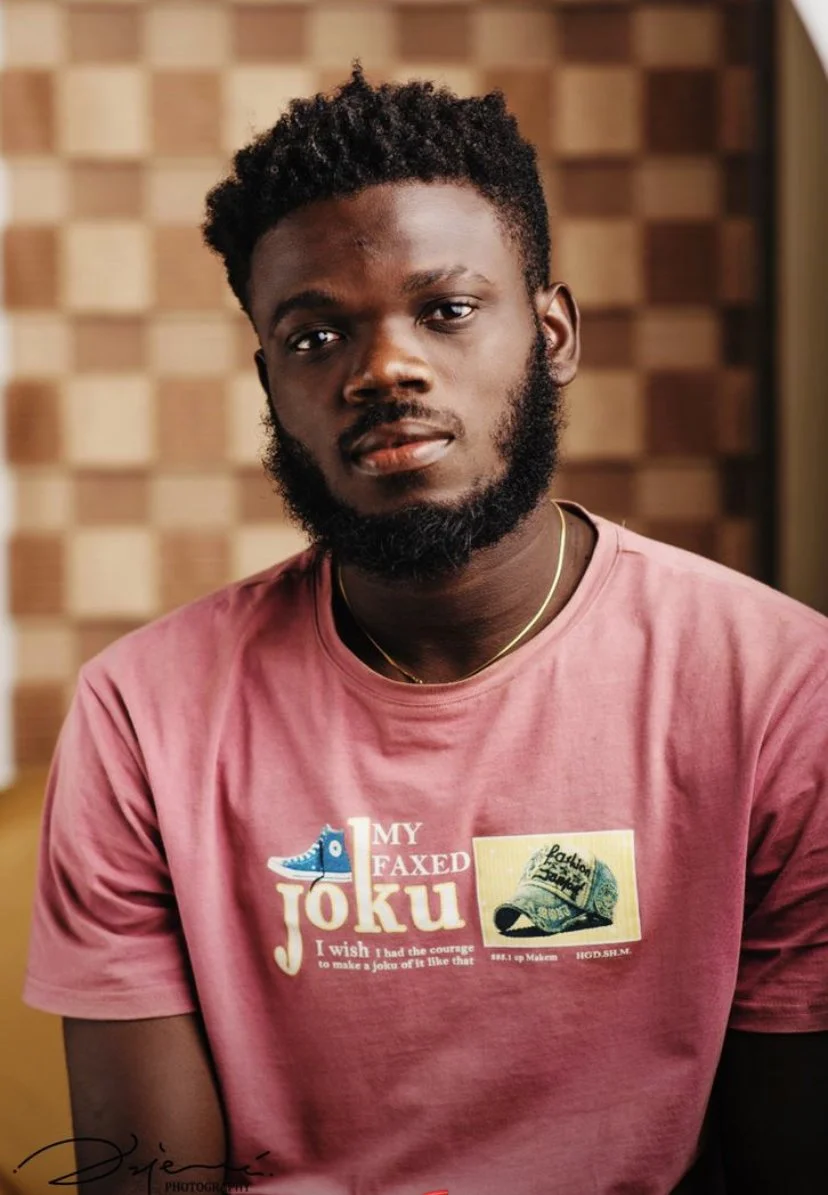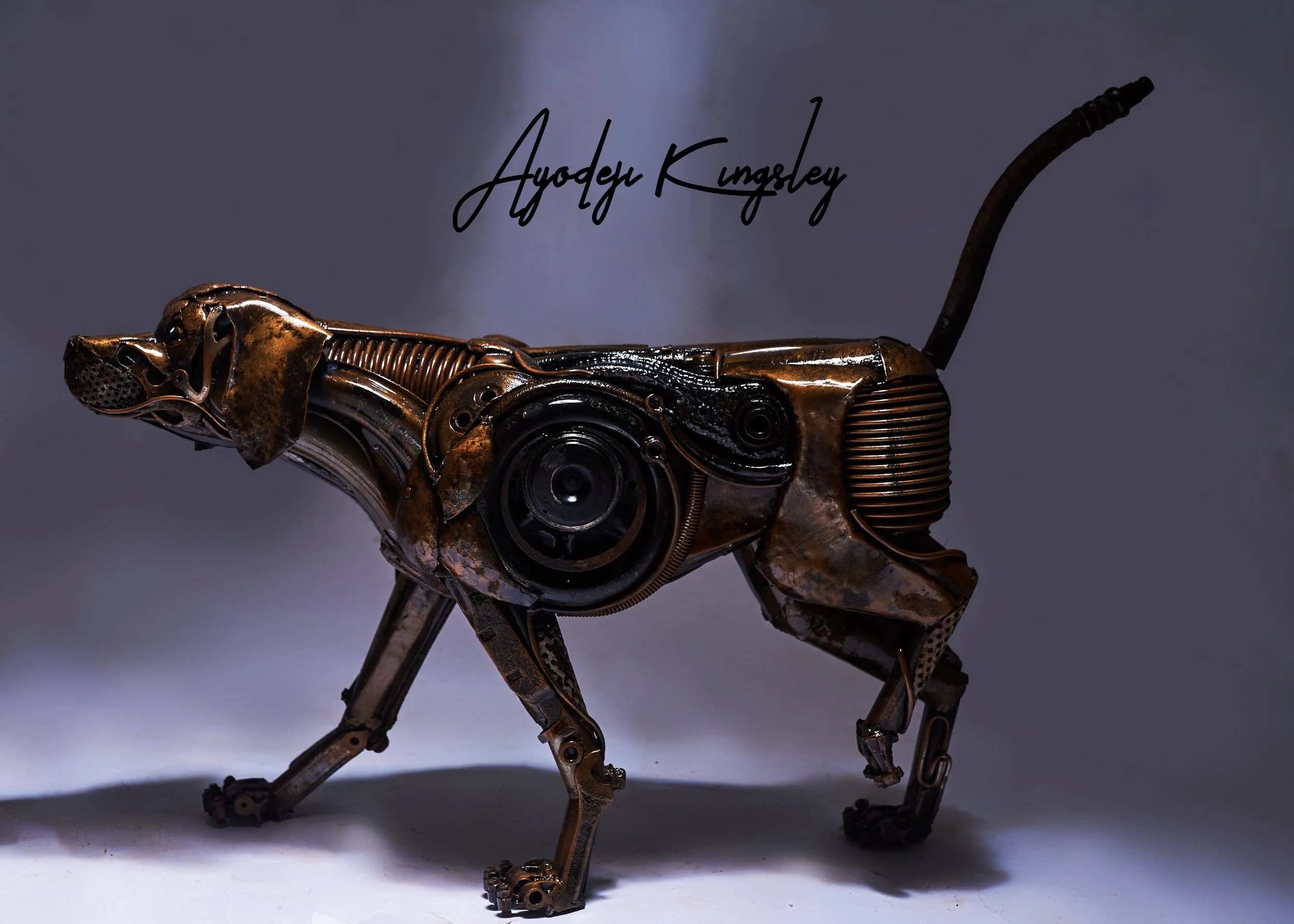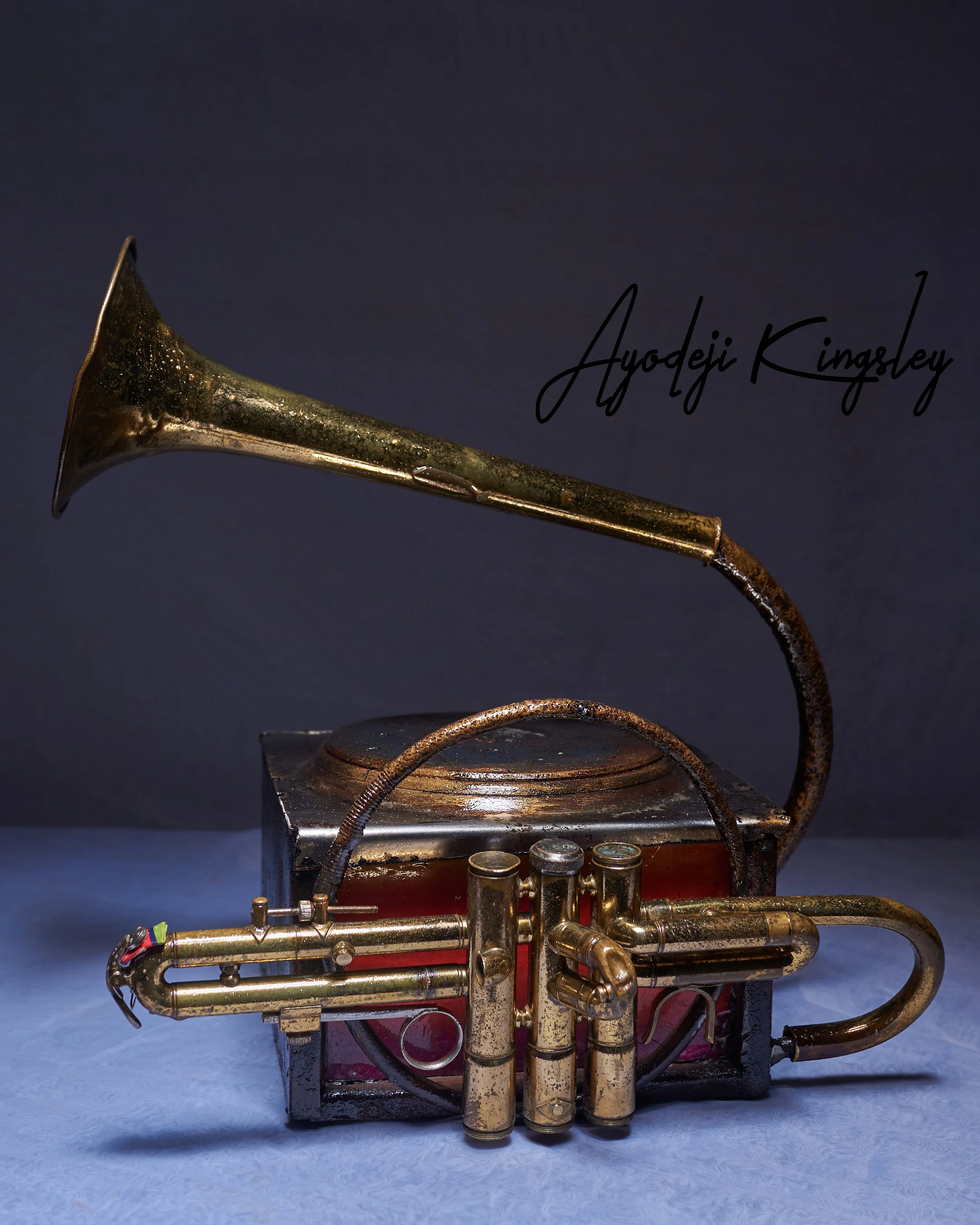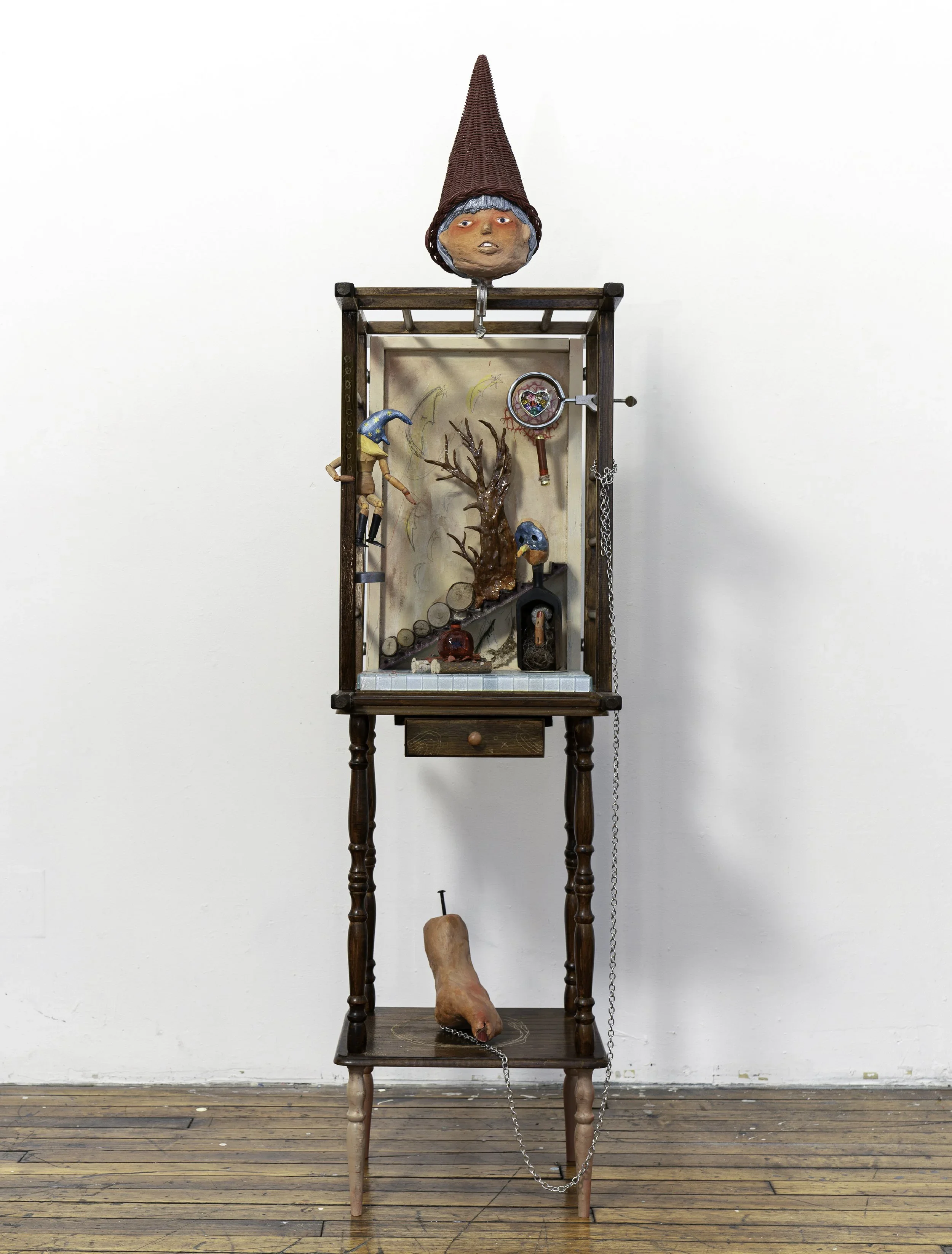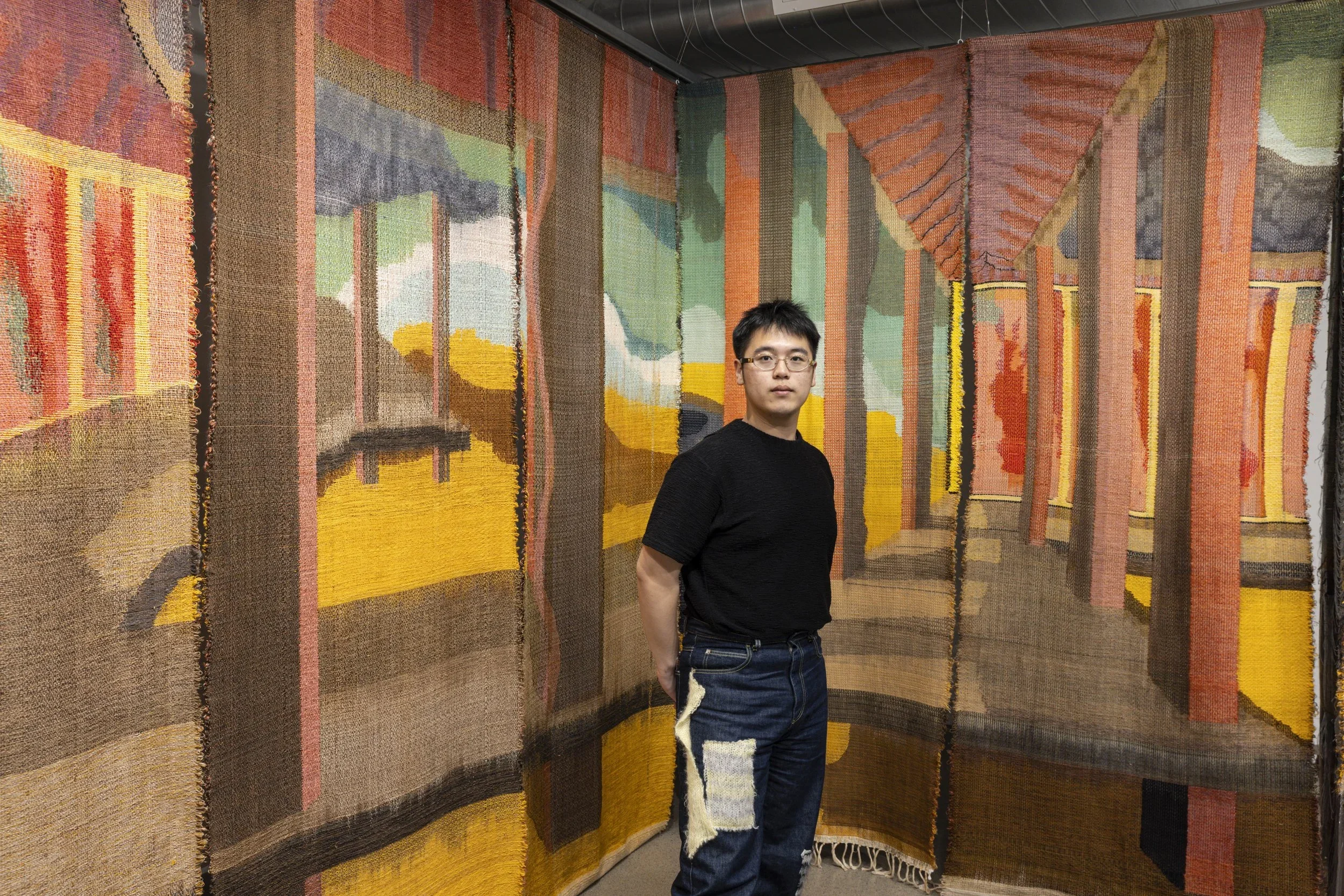10 Questions with Ayodeji Kingsley
Ayodeji Kingsley is a Nigerian-born artist based in Derby, United Kingdom, who predominantly works with metal in his sculptures. Ayodeji has a bachelor's degree in chemical engineering from Obafemi Awolowo University in Nigeria and a master's in environmental control and assessment from the University of Derby in the United Kingdom.
Ayodeji's artistic side was awakened at a young age, and he excelled in fine and creative art throughout his basic and secondary education. Over the years, he has developed his own imaginative and conceptual mind through drawing, paronomasia, making graphic illustrations and, most recently, sculpting. Initially, to supplement his income during university, his digital art practice began as a creative outlet and source of extra cash. However, the act of creation was far more than a mere means to an end. After completing his first degree, he consciously transitioned from a part-time pursuit to a dedicated artistic career by taking tutelage from artists in the country, self-development, and attending exhibitions.
As a passionate environmentalist/artist motivated by a deep fascination with salvaged metals' raw power and inherent beauty, Ayodeji has worked on a pre-existing art concept but with a different expression lens. He has thought through and taught the magnificent use of what others see as waste, bringing them together in the praxis of pleasing aesthetics to express familiar ideas and entities such as animals, tools, items and lots more. He transforms discarded machinery, tools, and industrial detritus into evocative sculptures that explore themes of decay, rebirth, and the cyclical nature of existence.
Ayodeji Kingsley infuses mediums to facilitate an interface between the subject and the viewer. Ayodeji draws inspiration from various sources, including everyday situations, nature, personal beliefs, and communication with other artists. The principal themes in his works are surrealism, paronomasia and deeply entrenched African Proverbs. He strives to express these elements in his psychological approach to his artistic expression—a perfect reflection of the evolving and kaleidoscopic world around us.
Throughout his career, Ayodeji has created a remarkable body of work that has received widespread recognition. His works have been shown in a variety of shows and galleries, both online and in person, across the globe. He has completed several commissioned works, including public sculptures in his home country, Nigeria. His work has captivated audiences across multiple platforms.
Ayodeji Kingsley - Portrait
ARTIST STATEMENT
“My sculptures invite the viewer to explore the depths of the human psyche. I aim to evoke a sense of wonder and introspection, inviting viewers to connect with their subconscious. By blending surrealism, paronomasia, and proverbs, I seek to challenge traditional notions of form and meaning.
My work is a visual language, a dialogue between the artist and the viewer as I invite you to navigate through my mind's eye, to experience the world as I see it, filtered through the lens of imagination and emotion. The intricate patterns and textures inspire me in nature, and I strive to incorporate these elements into my sculptures. By combining the raw power of metal with the delicate beauty of organic forms, I create strong and sensitive pieces. Each sculpture manifests my thoughts and feelings, a tangible representation of the intangible. Each sculpture is a testament to the power of human ingenuity and the beauty of the natural world.
The process of creating these sculptures is a meditative journey. I find solace in shaping, moulding, and bringing form to formlessness. It is a way to connect with the divine and appreciate the world's beauty and complexity.
In a world adapting to the consequences of unrestrained consumption, my art poignantly reflects our interconnectedness with the environment. I utilise discarded metals, remnants of a society obsessed with material acquisition, transforming them into sculptures and installations that challenge our perceptions of waste and inspire a deeper understanding of our ecological footprint. By breathing new life into discarded materials, I strive to highlight the inherent value in discarded objects and advocate for a more sustainable and equitable future while addressing other necessary societal issues.
Art has the power to transform lives. It can inspire, console, and provoke thought. I hope my sculptures will leave a lasting impression on viewers, encouraging them to look beyond the surface and delve deeper into their consciousness.”
— Ayodeji Kingsley
IMMIGR-ANT, ScrapMetal, 40x14X19 inches, 2025 © Ayodeji Kingsley
INTERVIEW
You initially studied chemical engineering and environmental assessment before turning to art. How did that background influence your journey into sculpture and artistic expression?
My initial pursuit of engineering was rooted in a deep-seated inclination towards problem-solving, resourcefulness, and innovation – skills fostered during my formative years, perhaps influenced by a societal perspective that often relegated creativity to a hobby rather than a viable primary path. My subsequent transition to a full-time art practice arose from an exploration of my previously neglected artistic and creative talents, and these two paths are inextricably linked. The skills I acquired during my engineering training have proven invaluable in the artistic exploration of that same resourcefulness, innovation, and problem-solving ability. Notably, my engineering background provided a robust understanding of structural integrity, a cornerstone of my sculptures and, most essentially, public sculptures, as well as proficiency in machining techniques such as welding and CNC cutting and shaping, essential tools for a metal sculptor.
In the same view, my decision to pursue a postgraduate degree in Environmental Assessment was directly inspired by my burgeoning passion for transforming discarded metals and materials into evocative monuments. My artistic practice inherently aligns with the principles of sustainability and actively supports the transition towards a green energy future. By repurposing discarded metals, my work underscores the significance of sustainable practices in forging a more environmentally conscious future – a conviction further solidified by my pursuit of a postgraduate degree in Environmental Control and Assessment.
Dash of Hope, Metal Scrap, 45x26x44 cm, 2023 © Ayodeji Kingsley
Can you tell us about the moment when art moved from a side project to a dedicated path in your life?
While growing up, I probably prioritised my problem-solving skills, resourcefulness, and excellence in STEM classes. I wouldn't say I disregarded my creativity, but it wasn't the primary focus. It was always evident in how I approached things – the way I organised my space, how I structured my notes, the sketches made in my notes at Natural science classes and generally how I navigated the world.
However, the defining moment, the catalyst that really shifted my perspective, came years after I had left primary education. Apparently, some of my art projects from that time were still being exhibited in the school's art studio. My younger sibling, who later attended the same school, called me with a rather amusing story. He mentioned that my old projects were still there, and it was causing him some good-natured ribbing. His peers were playfully suggesting he had a high bar to meet, given my past work.
More significantly, my former art tutor, who also taught him, inquired about me and expressed hope that I was seriously pursuing art. Coincidentally, at that time, I was creating graphic art for leisure, an interest sparked by my childhood love for cartoons and animated figures. I found learning graphic art quite interesting and easy. Positive reviews from friends and family, coupled with that specific comment from my former tutor and other encouraging words, served as a potent reminder of my artistic talent and creativity. It was a moment of profound reflection.
This realisation coincided with my studies in engineering. Initially, I explored my artistic side on the side, almost as a passion project alongside my academics. However, after graduating with my engineering degree, I decided to fully dedicate myself to art. It was a transition, a re-prioritisation, driven by that recognition of my long-standing creative abilities and the encouragement to pursue them wholeheartedly.
For many, the innate identity of an artist is discovered early in life and remains constant, irrespective of other pursuits or age. While active engagement may vary, the fortunate can eventually embrace this fundamental aspect of themselves.
Your sculptures are made from salvaged metals. What draws you to work with discarded materials, and how do you see them as more than just waste?
My hands instinctively reach for the discarded, the forgotten. I would say the inbuilt resourcefulness, innovative and problem-solving skills from my formative years played a major role in choosing my medium and technique. It really does come down to my boyhood passion for creating and building things out of nothing. I saw myself transition from building as an engineer to building from a more artistic and creative mind, which ultimately blossomed into my love for animated figures and sculptures.
Scrap metals or discarded materials, as a medium, felt different to me than conventional sculpting techniques. It offered an avenue to combine the resourcefulness and innovative skill ingrained in me, alongside my engineering view of building something out of nothing, all supported by my artistic and creative talent, thereby fostering ingenuity.
Moreover, I see these materials as so much more than waste. They possess unique aesthetic possibilities with the sheer variety of shapes, textures, forms, and the patina of time evident in them. Rust, corrosion, and the scars of industrial use imbue each piece with a unique character. I also feel they have a tendency to celebrate the aesthetic value of imperfection, mirroring the natural world's cyclical processes of decay and regeneration. Considering my own path and transition, it could also be seen as a powerful metaphor for renewal and the possibility of finding beauty and value in unexpected places.
PAW-SITIVE, Scrap Metal, 10x32x26 inches, 2021 © Ayodeji Kingsley
POUCHED IN INEQUITY, Metal scrap, 10x40x29 inches, 2020 © Ayodeji Kingsley
Many of your works explore surrealism, paronomasia, and African proverbs. How do these themes interact in your pieces?
The way surrealism, paronomasia, and African proverbs interact in my sculptures is like a deliberate unravelling of the expected. Surrealism is the initial crack in the surface, disrupting conventional expectations by placing disparate elements side-by-side. It's an invitation to step away from established realities and wander into the landscape of the subconscious.
Then comes the playfulness of paronomasia. Through visual puns and a deliberate equivocality, I aim to subvert singular interpretations. It's about creating a fluidity of understanding, where a form might suggest one thing but playfully hint at another.
And woven throughout are the African proverbs, familiar nuggets of wisdom presented in unfamiliar contexts. Stripped of their usual linguistic home, they gain a new resonance in sculptural form, prompting a re-evaluation of their ingrained meanings.
Together, these elements forge a visual language that resists easy categorisation. The dreamlike logic of surrealism undermines predictable forms, while paronomasia introduces ambiguity and humour, fracturing fixed meanings. The proverbs, embodied unexpectedly, gain a new and often unsettling power.
This deliberate disruption is intentional. I want to encourage viewers to move beyond conventional aesthetics and engage in a more active, introspective process of meaning-making. Ultimately, it's about challenging traditional notions of what sculpture can represent and how it communicates.
You've described your process as meditative and spiritual. What does a typical day in your studio look like?
My sculptural process with discarded metals unfolds as a dynamic dialogue between my initial artistic concepts and the intrinsic character of the materials I discover. It commences with a phase of conceptualisation, where nascent ideas take hold in my imagination. These are then translated into a sketch, a two-dimensional blueprint that captures the essence of the envisioned form. Often, I proceed to create a three-dimensional maquette, typically in clay, to further refine the spatial relationships and overall composition.
With the envisioned form thus established, each day in my studio feels like a fresh encounter, a new beginning in my interaction with the discarded materials and metals. I approach them as if meeting them for the very first time, meticulously scrutinising and observing the pieces I have gathered, using my maquette or two-dimensional drawing as a guiding reference. This process, which I consider a kind of ritual, allows me to familiarise myself with the materials in a new dimension, offering fresh perspectives each day. It's during these moments of focused observation and meditation that a series of new ideas and creative sparks invariably arise. These periods of intense engagement can last anywhere from a few minutes to several hours before I proceed with or begin whichever project is at hand.
Tripple H (High-Hopes-Heron), Metal Scrap, 2021 © Ayodeji Kingsley
How does your work reflect your environmental values, and what message do you hope viewers take away in terms of sustainability?
My work is intrinsically linked to my environmental values, acting as a tangible manifestation of my commitment to sustainability. By choosing discarded metals as my primary medium, I aim to directly engage with the issue of waste and overconsumption. These materials, often overlooked and deemed valueless, are given a new life and purpose through my sculptures. In essence, I'm taking what society has discarded and transforming it into something that hopefully sparks contemplation and appreciation. I see the inherent beauty and potential within these forgotten objects. The rust, the dents, the marks of previous use – these are not imperfections but rather a testament to the material's history. By celebrating these "flaws," I hope to encourage a shift in perspective, prompting viewers to reconsider what they deem as waste and to recognise the latent value in the things around them.
The message I hope viewers take away in terms of sustainability is multifaceted. Firstly, I want to highlight the sheer volume of resources that are discarded and encourage a more circular approach to materials. Secondly, I aim to demonstrate that beauty and artistic merit can be found not just in pristine, newly manufactured materials, but also in the repurposed and recycled materials. Ultimately, I hope my work inspires a greater sense of responsibility towards our planet and encourages a more mindful and creative engagement with the resources we have. If even one person leaves my exhibition thinking differently about what constitutes "waste" and the possibilities of reuse, then I feel my work has served its purpose beyond its aesthetic value
You've completed several public commissions in Nigeria. How has the reception to your work differed between Nigeria and the UK?
The reception to my public commissions differs notably between Nigeria and the UK due to cultural nuances and spatial constraints. In Nigeria, there's a deeply rooted connection to art as a form of storytelling and cultural expression. Public engagement is often direct and personal, with interpretations readily drawing upon local narratives and proverbs, fostering a vibrant sense of communal ownership.
Conversely, in the UK, while appreciation exists, the reception tends to be more reserved, viewed through a lens ofcontemporary art discourse and conceptual frameworks. Cultural references that resonate in Nigeria may require more nuanced understanding in the UK.
Space also plays a crucial role. Nigeria's expansive land allows for private collectors to more easily acquire and display large-scale sculptures. In contrast, the UK's limited land mass and regulations often restrict private monumental collecting, steering the market towards smaller pieces. Consequently, large works in the UK predominantly find their place in designated public areas.
Owl Clock, Metal scrap, 46x25 inches, 2020 © Ayodeji Kingsley
Owl Clock, Metal scrap, 46x25 inches, 2022 © Ayodeji Kingsley
You mentioned being inspired by everyday life, nature, and conversations with other artists. Can you share a recent moment or experience that sparked a new idea?
Firstly, my artistic practice has cultivated a heightened sense of observation. Training the eye fosters a distinct way of perceiving the world, allowing me to notice subtle nuances in human movement and interaction, which subsequently inform my work. My current project, focusing on individuals' reactions to news and rumours, heavily utilises observations of how people instinctively project mental imagery triggered by verbal input, rather than direct visual evidence.
Furthermore, I value my connection with a supportive community of artists who understand that mutual encouragement benefits everyone and enhances overall engagement with art. This collaborative environment provides a significant and healthy source of inspiration for my creative endeavours.
What challenges have you faced in merging engineering precision with artistic intuition, especially when working with industrial materials?
Art often involves transforming imagination into tangible reality, heavily relying on creative energy. In projects where final forms are idealised or suggestive, spontaneity can take precedence, making strict precision less critical.
However, when the goal is to actualise and interpret real-life forms into sculpture rather than more of idealised or suggestive ideas , creativity requires a partner: precision. While essential, this need for accuracy must be carefully managed. The main challenge arises here, particularly in reconciling the ingrained engineering mindset that seeks exactitude and predictability with the artistic drive for spontaneity and exploration. Art, by its nature, thrives on ambiguity, unexpected discoveries, and the freedom to transcend conventional applications.
Furthermore, the necessity for structural integrity can sometimes feel like an intrusion on artistic freedom of expression.Ultimately, the successful merging of these seemingly different approaches is an ongoing learning process. It demands a conscious balancing act between analytical rigor and intuitive exploration, allowing the project to be seen not just as a structural endeavour but also as a vehicle for history and expressive potential.
HEAT MAKER, Scrap Metal, 16x12x15 inches, 2020 © Ayodeji Kingsley
Looking ahead, what projects or themes are you excited to explore next in your artistic practice?
My future artistic explorations will intensely focus on environmental consciousness through an expanded use of discarded materials. I envision more intricate, large-scale sculptures that showcase the unexpected beauty and potential inherent in these resources, pushing the boundaries of repurposing. I'm keen to experiment with new techniques for combining diverse discarded elements, including plastics, tyres and textiles alongside metals, to create richer textural and conceptual dialogues.
Beyond materials, I'm drawn to social commentary with subtle activist undertones. My aim is to create evocative pieces that prompt reflection on societal issues, fostering deeper awareness of our relationship with the environment and each other. A key plan involves collaborating with like-minded artists in workshops, creating a joint body of work for temporary public display. These pieces will then be auctioned, with proceeds donated to causes relevant to the explored themes, such as knife crime awareness, support for mothers who have experienced stillbirth, or homelessness. By giving voice to the discarded, both materially and conceptually, I aspire to create art that resonates deeply, encouraging bothaesthetic appreciation and critical engagement.
Artist’s Talk
Al-Tiba9 Interviews is a promotional platform for artists to articulate their vision and engage them with our diverse readership through a published art dialogue. The artists are interviewed by Mohamed Benhadj, the founder & curator of Al-Tiba9, to highlight their artistic careers and introduce them to the international contemporary art scene across our vast network of museums, galleries, art professionals, art dealers, collectors, and art lovers across the globe.


